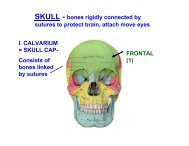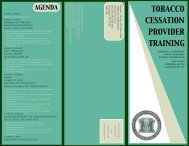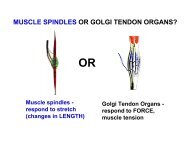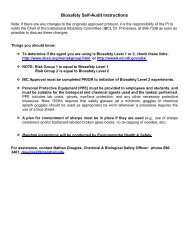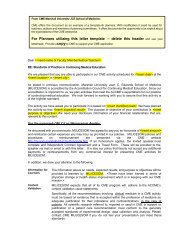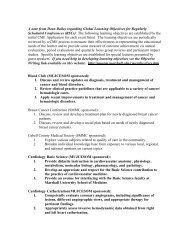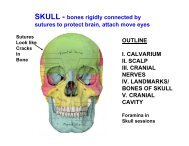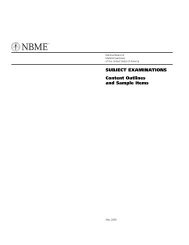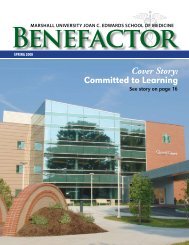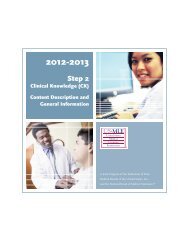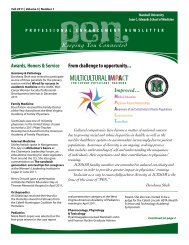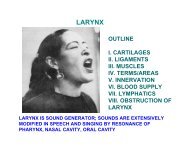FA 5 Progress Report WV-INBRE - Joan C. Edwards School of ...
FA 5 Progress Report WV-INBRE - Joan C. Edwards School of ...
FA 5 Progress Report WV-INBRE - Joan C. Edwards School of ...
- No tags were found...
Create successful ePaper yourself
Turn your PDF publications into a flip-book with our unique Google optimized e-Paper software.
Program Director/Principal Investigator (Last, First, Middle): Rankin, Gary O 65115-021-005 7,080 88.88 36.16 43.39115-021-006 7,730 88.36 35.82 44.68115-027-001 6,478 87.99 36.09 37.79115-027-006 3,728 87.71 36.09 16.99115-027-007 6,056 87.68 35.91 31.43115-027-009 5,630 86.38 35.43 31.81115-027-012 4,990 88.25 36.10 33.57115-027-015 5,036 88.92 36.19 32.70115-027-027 5,964 88.68 36.12 43.34115-027-032 5,264 88.70 35.93 37.30115-027-033 7,856 88.00 35.70 61.58115-027-034 7,258 88.28 35.87 56.77total bases 135,3465. Results:We enrolled FCH families where the proband was either an affected juvenile or adult member.We identified candidate genes for FCH susceptibility by applying a series <strong>of</strong> filtration steps. For ourwhole exome sequencing approach, we focused our efforts on the 22 largest families (15 with ajuvenile proband and 7 with an adult proband). These 22 FCH families met the criterion for havingat least one normal + two affected members. 18/22 families have 3 affected. At least 2 members <strong>of</strong>the 22 families had completed the re-consent process.LDLR mutations: Since ~20% <strong>of</strong> FCH patients have been shown to have mutations in LDLR (andtherefore have a form <strong>of</strong> FH), we sequenced all LDLR exons in at least two affected and onenormal person in 20 <strong>of</strong> the 22 “3+ affected” families, via long-range PCR. We successfullysequenced 100% <strong>of</strong> all 18 exons in 10 families and ~90% <strong>of</strong> the exons in 8 families. Two family’sDNA (116004 and 117008) failed to amplify in long-range PCR. In our analysis <strong>of</strong> LDLR variants, weexcluded all synonymous variants and those missense variants which had allele frequenciesgreater than 10% since they were unlikely to result in nonfunctional LDL receptor. Of the 18 familieswith LDLR data, 4 families carried rare, deleterious mutations in an LDLR exon:(1) Affected members <strong>of</strong> Family 115006 had a known cysteine to serine at amino acid 56 (C56S) inexon 3 (adult proband)(2) Affected members <strong>of</strong> Family 116001 had a novel splice donor SNP in exon 9 (juvenile proband)(3) Affected members <strong>of</strong> Family 116002 had a known splice donor SNP in exon 3 (juvenile proband)(4) Affected members <strong>of</strong> Family 117001 had a known 11 bp duplication in exon 4 (adult proband).Figure 1 illustrates the effect <strong>of</strong> the “frameshift” insertion in initial sequence readout beginning atbase 563.Figure 1. Sequence <strong>of</strong> LDLR exon before and after the point in insertion. Notice that after base 563,there are two base calls at each position resulting from heterozygosity in the participant.All mutations were present in phenotypically affected and absent in phenotypically normal members(minimum <strong>of</strong> four individuals). Three <strong>of</strong> the four mutations had been identified in prior studies. It isnot clear why these “LDLR-defective” individuals have elevated triglycerides.Whole exome sequencing and analysis <strong>of</strong> Family 115027Based on LDLR analysis, 14 families were qualified to move onto whole exome sequencing (that isthere were no demonstrable deleterious mutations in LDLR in these families). Because wemultiplexed samples in the paired-end sequencing, we were able to economically sequence thewhole exomes <strong>of</strong> 41 individuals from six FCH families as shown in Table 2.PHS 2590 (Rev. 06/09)Continuation Format Page



